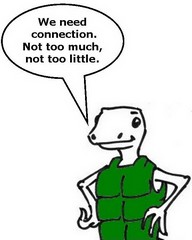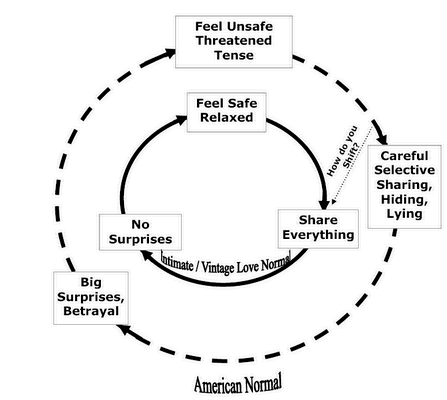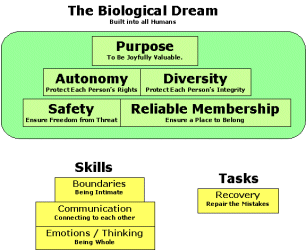Map of Relationships (Full Version Script) Part VI
Section 6: Questions and Answers (CLICK HERE to print entire Map.)
© Al Turtle 2006
A Visit to the University of Life
Now you have the Map of Relationships in your hands. Now, the choices are yours. Let me share some answers to questions that many before you have asked. 
People ask me about the University of Life, as they often put this right ahead of them. Well, I remember it well. It took a long time. I think it starts with a solid awareness in both partners that what is now going on isn’t working for either of them – an awareness that they have to try something new. I believe to keep going you need two things: panic and commitment. You need to feel panic that the Biological Dream is not yet fully alive. And you need the commitment to go forward together. I had to learn a lot that my parents didn’t and couldn’t teach. No one had taught them. I often say, “My parents, doing the very best they could, did a fairly poor job raising me.” I had to become an expert at many things subjects and skills they didn’t know.
I tell people who are in the Power Struggle and who want to go after that Biological Dream, “What you are doing is earning you what you have in the way of a relationship. You have to learn to do, I repeat, to do things differently.” I learned from many sources. So can you. Remember that original 4% had no help at all. Now there are lots of books, seminars, workshops, and courses out there. I have not reviews all of them. I learned a lot from Harville Hendrix’s Imago Relationship Therapy, both the workshops and the in-office therapy. There are hundreds of his therapists and workshop presenters out there willing to help you. I learned a great deal from John Bradshaw, who’s books helped me visualize much of the work I had to accomplish.
Now, so many books are self-help books… and are not relational. I like to think that self-help books are about how to live on a desert island – alone. Yet everything about the Biological Dream is about getting along with others, because that is a need of the self. Relational books are about what you need to know when someone else swims ashore and live with you on your desert island. Some of the most critical skills of Relational Maturity aren’t being taught anywhere that I can find. As a result, I am putting that material together myself and will make it available.
Most of what you have to learn are skills. I think of skills as habits – things you do automatically without thinking. A new skill is hard to do for the first 50 times, only a little difficult for the next 100 times, and simply automatic after that. Since skills are trainable, visible and even measurable, I believe you can measure you success as you advance. I think Relational Maturity is easy to see, and can be objectively measured.
One of the problems facing you is the difference between normal, North Americans and Vintage Lovers. You have to be willing to become a bit abnormal.
Another problem is that there are many people out there who are teaching Home Style skills. I suggest you beware of those who teachers and authors who haven’t reached Vintage Love themselves, but are willing to tell you how to do it. If their style and behavior conflicts with the Biological Dream, I suggest you stay away from them. Look for teachers who can show you what it looks like.
Besides, I don’t think you need books very much. I think you need direction in what to practice. Most of what I needed were new skills and help at removing old useless or destructive skills. One of the challenges each of us face is that “relationships are not an intellectual, nor a spectator sport.” Great relationships involve work, doing things that you are not inclined to do. Practice, practice and more practice.
Five Common Problems to Fix
In my office, I sit right at the entry way to University of Life. I assist couples to get firmly into the courses. I teach them all the freshman classes and share about the advanced classes if I can.
Every couple I’ve met presents one single common problem. They are using threat in an attempt to get love in their lives. They are threatening their partner, whether they know it or not. They are usually living with threat from their partner, and untrained to do anything about it. As Safety is the first principle of the Biological Dream, threat never works. I’ve learned that Love and Threat cannot coexist. PERIOD.
The University of Life has many courses, and I think all are necessary. The first line of Leo Tolstoy’s wonderful book Anna Karenina is “Happy families are all alike; every unhappy family is unhappy in its own way.” I like the quote. It points to a wonderful principle. Vintage Love implies that you’ve learned all your lessons. Miss one lesson, and it doesn’t matter which, you’ll be in trouble. This is why so many of all the courses in books, seminars or on TV don’t work. They point to the solution of one problem. But you will need to learn all the lessons.
Many people get the feeling that the learning is endless. Fortunately there are a finite number of courses and problems to solve. It is doable. Let’s look at the five most common problems people present to me: Being Together, Arguing, Control, Hurt, Lying. These, I believe, must be solved to get to Vintage Love. Remember that each of these paragraphs represent all or part of a course and just a part of the curriculum in achieving Relational Maturity.
1st: Being Together

Most couples have a problem with Reliable Membership that simply tears them apart. One of them needs membership or intimacy much more than the other does. The “needy one” pursues, clings, interrogates, and pushes. Their partner, having lower need for intimacy, feels pursued, clung-onto, pestered, driven, and thus starts to withdraw. But by withdrawing they trigger their partner into pursuing, clinging etc. harder. And the cycle goes on. This problem gets bigger and bigger with more and more passion and panic. One wanting more contact. The other wanting more “space.” I’d say this is a problem in about 85% of couples I see…. and it must be solved. I was the needy one. Sandra was the one I used to drive away.
2nd: Argument

Almost all couples who enter my office have what I call a Type II Communication problem. A Type I problem means they can’t hear each other. But with a Type II, they listen to each other until a disagreement appears, and then they stop listening and start arguing. Disagreement prevents communication. Since arguing and interrupting are so common, many people don’t consider this a kind of fighting. But the effect on the relationship is enormously negative.
I believe firmly that, from the point of view of a relationship, arguing is the verbal form of physical violence. Just as arguing leads to violence, and violence lead to more and more violence, so also some verbal habits lead to arguing. Arguing can and must be replaced by different, quality communication.
3rd: Control
A significant majority of couples present me with their control problems. It seems that a large number of us are, shall I say, brainwashed in youth to believe that there are lots of rights and wrongs in life, and that we can relax if we are doing “right” and need to be tense it we are “wrong”. I’ve found the issue is not what is right or wrong, but that the individual becomes anxious when in the face of “things out of place.” Such a person tries to relax themselves by putting things into order, the order they have selected to believe in.
Sandra and I call these rules. She has a large set. I have another set. A rule is a way of doing things which relaxes an individual. Sandra relaxes when cupboard doors are closed. I relax when a computer is turned off methodically. We both relax when a room is picked up and clean. These are our rules. A control problem occurs when I leave cupboard doors open or Sandra turns off a computer at the wall switch. What we do causes our partner to tense and they try to relax by changing us.
One of the major sources of lowered tension or of safety is to have a sense of control. In a couple, this is a special problem where one often tries to relax by taking control away from the other, who then tenses. It is a great learning how keep both partners relaxed with a sense of control for both….. at the same time.
4th: Hurt
An amazing number of people believe themselves responsible for other people’s pain. In that story I told you of the couple that divorced after 23 years, the woman kept her unhappiness hidden from her husband for 22 years because she didn’t want to hurt him. She lied to him so as to not hurt him. Ask yourself, did it hurt him more for her to keep it a secret or to share it. I’ve found this belief in protecting people from pain doesn’t work.

One of the things I found out was that people learn when they are in pain. When everything is going well, they tend to remain asleep to what they can learn in life. If I look back, most of the great things I have learned have come from a time of pain. Thus I’ve learned that protecting adults from pain, especially the pain they earn themselves, isn’t very useful. It tends to keep them in a state of ignorance.
But it is quite a skill to be available to a partner when they are in pain, and let them feel it fully.
5th: Withholding the Truth
Another major problem is the people do not tell each other the truth they see. They lie. They say “that which is not so.” However, the most common form of lying is what I call the passive lie – not saying the truth, just being silent. I had to develop a definition of lying that would cover both the active and passive. Here it is.

“To knowingly leave someone in a state of misunderstanding about something that you believe is important to them.”
I’ve found that people lie, and that people are silent, for only one reason. I’ve found that people lie because it is not safe to tell the truth, and people are quiet because they don’t think it safe to speak. Learning how to make it safe for your partner to tell the truth or to feel safe to speak leads both of you hearing the truth in a safe way. This is one of the first courses in the University of Life.
Curriculum
I suggest you think of the University of Life as going to college. And everyone is accepted who want to go. There will be Introductory courses and eventually advanced courses. While there are no examinations, clearly you can’t move to a sophomore level until you have demonstrated competence at the freshman level.
 Here are some examples of Freshman Year courses. I present these as they come to me.
Here are some examples of Freshman Year courses. I present these as they come to me.
Safety – Learn the fundamentals of becoming a Source of Safety to your partner.
Reliable Membership – Learn the fundamentals of establishing a reliable and durable connection. Learn to take breaks in your relationship, while maintaining reliable attachment.
Diversity – Learn the fundamentals of dealing with multiple views of reality, and enjoying Differences.
Autonomy – Learn the fundamentals of encouraging partnership and eliminating argument.
Purpose – Learn the fundamentals of opening to each partner’s unique genius and purpose in life.
Communication – Learn fundamental skills of verbally connecting without interrupting, appreciative listening and durable curiosity.
Boundaries – Learn the fundamentals of Making and Maintaining the Lines between you and others, maintaining your self and staying relaxed.
Feelings/Emotions – Learning the fundamentals of having, and expressing healthy emotions, and protecting passion.
Healing – Learning the fundamentals of dealing with reactivity, taking advantage of frustrations, and healing the wounds they represent.
And last, but first as far as you are concerned, : Map of Relationships – an Overview and Introduction to the paths that lead to Relational Maturity. This course you are taking now.
The Most asked question
My most asked question is, “Can you get to Vintage Love without a dedicated partner?” My answer is “no”. Yes, you can learn lots of the theory and concepts without a partner. You can practice the skills a bit, too. You can audit a course in piano playing and learn a lot. But you have to put your hands on the keyboard. Relational Maturity can only be learned in a relationship.
You need a selected and dedicated partner to both give you practice and give you a reason to practice.
You need a dedicated partner to give you the continuity of a good audience to help you develop yourself and your self-esteem fully.
You need a dedicated partner to create a world separate and distinct from that of “normal” society.
You need a selected partner to heal the deep wounds you received in Childhood. Wounds are peculiar. I believe all wounds are wounds of relationship, which occurred in a relationship, and can only be healed in a relationship. The ideal person to help you heal is the one who created the wound. However, I believe the mind is able to accept a reasonable facsimile of the original wounding person. Fortunately, you will always fall in love with a reasonable facsimile.
You need to work as lab partners: sometimes leading and sometimes supporting, taking turns.
I think this is all necessary, if you don’t want to live alone on a desert island.
Click to Continue


Comments
Map of Relationships (Full Version Script) Part VI — No Comments
HTML tags allowed in your comment: <a href="" title=""> <abbr title=""> <acronym title=""> <b> <blockquote cite=""> <cite> <code> <del datetime=""> <em> <i> <q cite=""> <s> <strike> <strong>